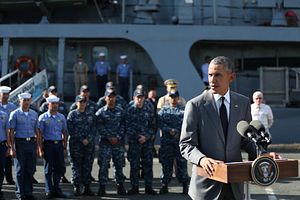The Philippine Supreme Court finally declared that a new defense pact signed between the Philippines and the United States nearly two years earlier is constitutional, local media outlets reported Tuesday.
The Enhanced Defense Cooperation Agreement (EDCA) – a pact inked in April 2014 between Washington and Manila that, among other things, would give U.S. troops and equipment wide access to Philippine military bases on a rotational basis – has been languishing in the face of a constitutional challenge in the Southeast Asian state. Though Philippine officials had been assuring outside observers that EDCA’s approval was a question of when rather than if, several deadlines had passed without a ruling into 2016.
On Tuesday, the Supreme Court finally voted 10-4 to uphold the constitutionality of the agreement. Four justices – Estela Perlas-Bernabe, Arturo Brion, Teresita Leonardo-De Castro and Marvic Leonen – dissented from the ruling, while Francis Jardeleza inhibited.
With that, the Court resolved the most contentious concern by opponents of the pact: that EDCA is actually a new treaty that requires Senate concurrence by a two-thirds majority, rather than an executive agreement in line with the 1951 Mutual Defense Treaty as the administration of Philippine president Benigno Aquino III has been arguing.
As I have argued previously, the approval is a significant development both for the Philippines itself as well as the U.S.-Philippine alliance (See: “Will the Philippines Approve a New US Defense Pact Ahead of Obama Visit?”). Resolving constitutionality issues around EDCA would allow defense officials to begin actually implementing arrangements – ranging from the construction of facilities to the prepositioning of defense equipment – that they have long been talking about. Getting that groundwork in place as soon as possible will be crucial as the Aquino administration which inked the agreement will soon be leaving office following upcoming presidential elections in May.
More specifically, these steps are vital to giving the Philippines – still one of Asia’s weakest militaries – what defense planners call ‘minimum credible deterrence’ in the face of a variety of threats including China’s assertiveness in the South China Sea (See: “The Truth About Philippine Military Modernization and the China Threat). With a ruling expected on the Philippine case against China in the South China Sea later this year, there is no telling how Beijing will react and Manila will need to be prepared for any fallout.
The Supreme Court’s decision is also a relief for the U.S.-Philippine alliance. Even if most had expected EDCA to eventually go through, legislative tests on U.S.-Philippine questions only conjure up nightmares of September 1991 when the Philippine Senate voted to end U.S. military presence in the country in a razor-thin 12-11 vote.
Timing-wise, the decision also usefully comes just as the two countries are set to begin their official ‘two plus two’ ministerial talks in Washington on Tuesday. The talks, which will see Secretary of State John Kerry and Defense Secretary Ash Carter meet with their counterparts, are expected to deal with regional security issues including the South China Sea and future U.S. military assistance to the Philippines. With the EDCA issue now all but resolved, both sides can both symbolically send strong signal about the alliance’s credibility and more substantively discuss next steps in defense cooperation.

































